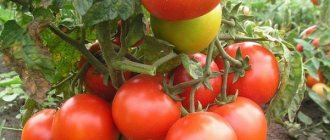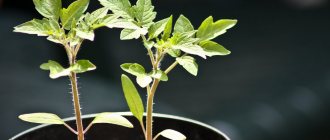Home / Vegetable garden / Tomatoes
Back
Published: 04/15/2018
Reading time: 3 min
0
The Agata tomato is an early ripening tomato that ripens in 100-115 days from the moment the seeds sprout. Its fruits have a sweet taste and are uniform in size. These tomatoes are great for canning and making salads.
- 1 Description
- 2 Productivity and cultivation 2.1 Features of cultivation in open ground
- 2.2 Feeding
Description of the variety
Early ripening Agata tomatoes ripen 100–115 days after the appearance of the first shoots. A determinate type crop, 35–45 cm high, produces 2–4 kg of yield per square meter. With careful care - up to 7 kg. In industrial conditions, up to 670 centners of tomatoes are harvested from one hectare.
Both seedling and non-seedling planting methods are suitable for tomatoes. The first option is considered more effective, in which you can achieve maximum results if you follow the basic recommendations.
Round fruits of the same size, weighing up to 100 grams, have a bright red color. The dense skin is not prone to cracking, which provides tomatoes with average transportability.
The universal tomato variety Agata is successfully grown in greenhouses, under film covers, and in open ground. Low-growing plants do not require staking, but it does provide adequate illumination of the fruits.
The taste qualities of tomatoes are estimated at 3.8–5 points. The pulp is fleshy.
Growing
The yield of Agata tomatoes depends on soil fertility and crop rotation. These tomatoes do well after carrots, onions, legumes and cucumbers.
When choosing a seedling method, seeds are sown in late March - early April to a depth of 20-30 mm. To protect against diseases, it is recommended to treat the seeds with a weak solution of manganese, after which they should be washed, discarding the floating ones, and dried.
The readiness of the Agata tomato for picking is indicated by the appearance of two leaves. Two weeks before planting outside, hardening of the bushes begins, for which the temperature in the room or greenhouse decreases.
See also
Description of the Pink Lady tomato and cultivation using the Dutch method
Read
Transplanting plants into open ground
Tomato Agata is transferred to open ground, under film cover, on May 15–20, provided the frosts have ended. When replanting plants in the second decade of June, the film does not need to be used.
Planting pattern: 50x50 cm - no more than four plants per square meter.
Features of agricultural technology of tomato Agata
The variety is not capricious and demanding to care for; the rules of its agricultural technology are simple and do not pose any difficulties for the average gardener.
Landing
How to eliminate lower back pain yourself without doctors or medications
Free online master class where you will learn how to eliminate lower back pain at home.
Become a member
First of all, you need to purchase high-quality tomato seeds, and this is not always possible. The fact is that, due to the growing popularity of the variety, some unscrupulous manufacturers and sellers are packaging seeds in colorful bags that do not correspond to the declared variety. Therefore, you should choose seeds from well-known, reliable manufacturers. In this regard, we can recommend the following:
- "Agrofirm Aelita"
- "Seeds of Crimea".
- "Agrosuccess" (Krasnodar).
- "Lucky Seeds"
Photo gallery: Agata tomato seeds of famous brands
Seeds TM Seeds of Crimea are popular not only on the peninsula
Aelita is a seed producer with a good reputation
There are a lot of positive reviews on the Internet about TM Successful Seeds
Seeds of TM Agrosuccess from Krasnodar are in demand.
When growing tomatoes in seedlings, the seeds for its production are sown 50-60 days before the planned transplantation into the ground. This means that if in the middle zone tomatoes are planted in open ground at the beginning - end of May, then they start growing Agata seedlings in mid-March - early April. A sign that seedlings are ready for planting is the presence of 5-6 true leaves and a bush height of 25-35 cm.
A sign that seedlings are ready for planting is the presence of 5-6 true leaves and a bush height of 25-35 cm
In regions where it is possible to grow tomatoes without seedlings, seeds are sown in the ground 3-4 weeks earlier than seedlings are usually planted. In this case, the best results will be achieved if the beds are initially covered with spunbond along arcs. The planting pattern for Agata tomatoes is two-line with a distance between rows of 50 cm and an interval between neighboring bushes of 40 cm. The normal planting density is 4 plants per 1 m2, acceptable is 6 bushes per 1 m2.
Care
Caring for Agata tomatoes is usual; we’ll just focus on some important nuances.
Garter
In field conditions, no one ties up Agata tomatoes, but if a gardener has planted several bushes (or several dozen bushes) on the plot, then it will not be a bad idea to help the plants not lie on the ground under the weight of the fruits. To do this, you can drive a wooden peg or a steel rod near each bush, to which you can tie the stems. Instead, you can mulch the soil in the garden bed with dry hay or straw - then the fruits lying on them will not rot.
Mulching tomatoes will prevent the fruits from rotting
Watering
For irrigation, it is better to use warm water, which is stored in barrels installed in open places. The variety does not need frequent watering - once a week is enough. In this case, water is poured under the root - it is undesirable for it to get on the leaves, as this can lead to burns.
Feeding
During the growing season, tomatoes need moderate feeding containing basic elements (nitrogen, potassium and phosphorus). It is better to add them as part of organic infusions prepared independently. For this, two feedings are prepared:
- Nitrogen.
Infusion of mullein, bird droppings or freshly cut grass in water. The selected component is placed in a barrel, filled with water and left for 5-7 days. After this, the concentrate is filtered and used as follows: add 2 liters of infusion to a bucket of water (1 liter in the case of using bird droppings) and pour one liter under each bush. Packaged chicken manure can be bought in the store - Potassium-phosphorus. An infusion of wood ash, which is prepared by dissolving 3 liters of sifted ash in a bucket of water. After 1-2 days, the plants are watered with it, one liter per bush. You can also use it for foliar feeding.
During the season, 2-3 feedings of each composition will be required, alternating them with an interval of 2 weeks. If it is not possible to prepare fertilizers yourself, then you can use urea or ammonium nitrate at a rate of 30-40 g/m2 as a nitrogen fertilizer, and potassium monophosphate at a rate of 10-20 g/m2 as a potassium-phosphorus fertilizer.
Treatments
Since all old varieties do not have sufficient immunity to fungal diseases, it would not be superfluous to carry out several treatments of tomatoes with a solution of biofungicide (fungicides are antifungal drugs) Fitosporin M Tomatoes. Since it is not addictive to pathogens and is safe for humans, it can be used an unlimited number of times and even during the harvest period. A bonus is the content of humic acids in the preparation, which increases plant immunity and helps increase productivity.
Features of care
Agata tomatoes require regular watering throughout the growing season.
There is no need to use cold water; the best option is warm, settled water.
Tomatoes require several feedings with mineral fertilizers - phosphorus or potassium. In the fall, ash, eggshells, and compost are added to the soil.
It is important not to skip the moment of watering and control the soil moisture, which should be moderate. Excess moisture leads to the appearance of fungus.
Advantages and disadvantages
Tomatoes belonging to this variety are characterized by early ripening and have many advantages:
- Readiness 95–110 days after sowing. The exact timing depends on the proposed conditions.
- Possibility of harvesting your own seeds due to the non-hybrid species.
- Compact bushes 35–45 cm high.
- Unpretentiousness.
- Average resistance to diseases.
- Doesn't need pinching.
- Arrangement of fruits on clusters of 3–6 pieces.
- The skin is glossy, smooth, dense, and does not crack.
- Convenience of preservation due to the fruit weight of 80–110 g.
- Rich aroma and taste without a sour tint.
- Good storage and transportation.
- High yield.
- Adaptation to different climatic conditions.
- It does not take steps and is not formed.
Negative features of the Agata tomato variety:
- Weak resistance to late blight.
- A thin stem that should be tied to a support at the time of fruit ripening.
These problems are inherent in most varieties of tomatoes and are completely solvable.
Reviews
Internet users who grow the Agata variety note it as a variety proven over the years, resistant to weather conditions and quite unpretentious in cultivation and care, subject to certain rules of agricultural technology.
In addition, they notice that even a novice vegetable grower without planting experience can grow this variety, since Agata is noted for its ease of care. Consumers indicate that the plant will bear fruit until late autumn frosts.
Most gardeners still recommend tying up the bush. This is due to the fact that it cannot withstand a large number of fruits and leans towards the ground, which is why the tomatoes rot. The fruits have a sour, not very sweet, but rich taste.
Thus, the variety is recommended for planting in summer cottages.
Pests and diseases
The characteristics of an early ripening variety imply a tendency to all sorts of diseases. Brown spots often appear on the stem, leaves and fruits of Agata tomatoes, indicating late blight infection. The yield of tomatoes decreases, as does the taste.
To prevent late blight, bushes are treated with Bordeaux mixture two weeks after planting in the soil. To prepare a protective agent, you will need to dissolve 50 g of slaked lime and copper sulfate in ten liters of water.
See also
Description of the mid-season Chile tomato and recommendations for growing tomatoes
Read
The medicinal solution can be used without personal protection, as it does not harm the human body. If desired, to combat tomato diseases, all kinds of ready-made chemicals are purchased and sold at specialized retail outlets.
Usage
The description of the Agata tomato variety indicates universal use. Tasty, sweet tomatoes are consumed fresh, used for preparing salads and canning. Small fruits easily fit into the neck of the jar. If you grind them, you get tomato juice, which lasts for months in a cool place. To preserve nutrients and fresh taste, the product is not brought to a boil, but heated to 70 degrees and covered with a metal lid. Tomato paste is prepared in a similar way.
The Agata tomato variety can be stored fresh for quite a long time, which explains the vegetable’s demand among farmers and managers of agricultural enterprises growing tomatoes for sale.
The sweetest and best varieties of tomatoes for greenhouses
Those gardeners who prefer not to buy tomatoes on the market, but to grow them themselves in a greenhouse, are, of course, interested in the question - what varieties of tomatoes are best to choose for greenhouses? After all, you want your vegetables to be not only beautiful, but also juicy and tasty. Experts have divided all types of tomatoes into determinate and indeterminate, depending on growth and some other parameters. It is among them that we will help you choose the best ones.











